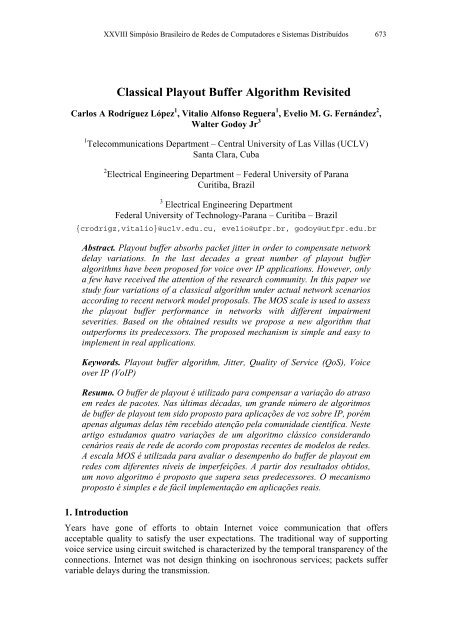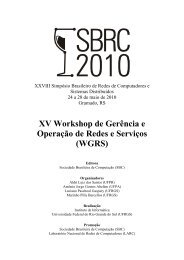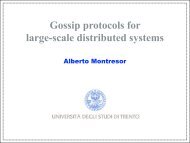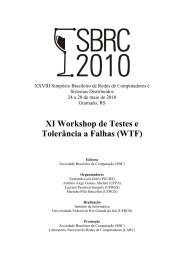Classical Playout Buffer Algorithm Revisited
Classical Playout Buffer Algorithm Revisited
Classical Playout Buffer Algorithm Revisited
Create successful ePaper yourself
Turn your PDF publications into a flip-book with our unique Google optimized e-Paper software.
XXVIII Simpósio Brasileiro de Redes de Computadores e Sistemas Distribuídos 673<br />
<strong>Classical</strong> <strong>Playout</strong> <strong>Buffer</strong> <strong>Algorithm</strong> <strong>Revisited</strong><br />
Carlos A Rodríguez López 1 , Vitalio Alfonso Reguera 1 , Evelio M. G. Fernández 2 ,<br />
Walter Godoy Jr 3<br />
1 Telecommunications Department – Central University of Las Villas (UCLV)<br />
Santa Clara, Cuba<br />
2 Electrical Engineering Department – Federal University of Parana<br />
Curitiba, Brazil<br />
3 Electrical Engineering Department<br />
Federal University of Technology-Parana – Curitiba – Brazil<br />
{crodrigz,vitalio}@uclv.edu.cu, evelio@ufpr.br, godoy@utfpr.edu.br<br />
Abstract. <strong>Playout</strong> buffer absorbs packet jitter in order to compensate network<br />
delay variations. In the last decades a great number of playout buffer<br />
algorithms have been proposed for voice over IP applications. However, only<br />
a few have received the attention of the research community. In this paper we<br />
study four variations of a classical algorithm under actual network scenarios<br />
according to recent network model proposals. The MOS scale is used to assess<br />
the playout buffer performance in networks with different impairment<br />
severities. Based on the obtained results we propose a new algorithm that<br />
outperforms its predecessors. The proposed mechanism is simple and easy to<br />
implement in real applications.<br />
Keywords. <strong>Playout</strong> buffer algorithm, Jitter, Quality of Service (QoS), Voice<br />
over IP (VoIP)<br />
Resumo. O buffer de playout é utilizado para compensar a variação do atraso<br />
em redes de pacotes. Nas últimas décadas, um grande número de algoritmos<br />
de buffer de playout tem sido proposto para aplicações de voz sobre IP, porém<br />
apenas algumas delas têm recebido atenção pela comunidade científica. Neste<br />
artigo estudamos quatro variações de um algoritmo clássico considerando<br />
cenários reais de rede de acordo com propostas recentes de modelos de redes.<br />
A escala MOS é utilizada para avaliar o desempenho do buffer de playout em<br />
redes com diferentes níveis de imperfeições. A partir dos resultados obtidos,<br />
um novo algoritmo é proposto que supera seus predecessores. O mecanismo<br />
proposto é simples e de fácil implementação em aplicações reais.<br />
1. Introduction<br />
Years have gone of efforts to obtain Internet voice communication that offers<br />
acceptable quality to satisfy the user expectations. The traditional way of supporting<br />
voice service using circuit switched is characterized by the temporal transparency of the<br />
connections. Internet was not design thinking on isochronous services; packets suffer<br />
variable delays during the transmission.
674 Anais<br />
To solve this problem in VoIP connections a playout buffer is used. It serves as a<br />
temporal store for audio packets, absorbing delay variations and allowing the<br />
reproduction of the audio payload free of jitter. This operation introduces an additional<br />
delay. To establish the buffer size is an important task that has a tremendous impact in<br />
the packet loss rate and in the interactivity of the conversation.<br />
A considerable number of algorithms exist for adaptive playout buffer, a classification<br />
can be found in [Atzori and Lobina 2006] and [Narbutt, et al 2005]. The existing<br />
solutions have been evaluated using real audio packet traces or by means of discrete<br />
event simulations. Recently it was suggested in [ITU-T 2007] a model that statistically<br />
evaluates multimedia transmission performance over IP networks. In this paper a<br />
comparative study was carried out using packet traces generated according to [ITU-T<br />
2007].The performance of the algorithms is evaluated using de MOS scale computed<br />
through the E-model [ITU-T 2003]. Finally we propose a new playout buffer algorithm<br />
based on a classical mechanism described in [Ramjee et al 1994]. The obtained results<br />
evidences that our algorithm outperforms its predecessors with minimal computational<br />
cost.<br />
The remainder of this paper is structured as follows. Section 2 provides useful<br />
background for our work, including a brief description of four classical playout buffer<br />
algorithms; as well as the models used to generate audio packet traces and assesses the<br />
offered quality of service for voice communications. In Section 3 we reexamine the<br />
performance of typical playout buffers discovering an important regularity that has not<br />
been previously reported to the best of our knowledge. Based on this finding, in Section<br />
4 we propose a new algorithm that achieves the highest score. Section 5 concludes the<br />
paper.<br />
2. Background<br />
2.1 <strong>Playout</strong> <strong>Buffer</strong> <strong>Algorithm</strong>s<br />
During the last decades several algorithms have been introduced for the playout buffer.<br />
One of the top referenced algorithms by the research community is the one presented by<br />
Ramjee et al (1994). This algorithm adjusts the parameters of the playouts between<br />
audio bursts. Its basic functioning can be described as follow: for every incoming<br />
packet the mean network delay ( dˆ i ) and mean delay variation ( vˆ i ) are estimated, if the<br />
received packet is the first one in a talkspurt then the absolute delay p o is calculated as:<br />
p<br />
o<br />
= dˆ<br />
+ Ω ⋅ vˆ<br />
(1)<br />
i<br />
where Ω is set to 4 in the original implementation. For the ith packet in a talkspurt the<br />
reproduction time is set to:<br />
p i = ti<br />
+ po<br />
(2)<br />
where t i is the time stamp set by the transmitter. Four different algorithms have been<br />
proposed to estimate the mean network delay and are summarized in Figure 1.<br />
<strong>Algorithm</strong> 1 calculated the mean network delay using an approach suggested by<br />
[Jacobson V. (1988)] for estimating the round-trip-time in TCP connections. This<br />
i
XXVIII Simpósio Brasileiro de Redes de Computadores e Sistemas Distribuídos 675<br />
Figure 1. Pseudocode for <strong>Algorithm</strong> 1, 2, 3 and 4.<br />
algorithm uses an exponential weighted moving average whit a weighting factorα . The<br />
second algorithm (<strong>Algorithm</strong> 2) introduces a small modification to the first algorithm,<br />
changing the weighting factor α by β (a lower one) when the actual network delay<br />
exceeds its estimate. The idea is to react more quickly when the network delay increase.<br />
<strong>Algorithm</strong> 3 stands on a different approach, setting the estimated mean network delay to<br />
the minor network delay observed during a talkspurt. Finally, <strong>Algorithm</strong> 4 is designed<br />
to adapt fast enough to delay spikes. According to Ramjee et al (1994) this algorithm<br />
success to increase their delay estimate on detection of a spike and again to decrease<br />
their estimate once the spike is over.<br />
The delay variation estimate remains the same in the four algorithms and is calculated<br />
as:<br />
vˆ = vˆ<br />
− + (1−<br />
) dˆ<br />
1 α − n<br />
(3)<br />
i<br />
i<br />
where n i is the network delay experienced by packet i and α is chosen according to the<br />
selected algorithm (see Figure 1).<br />
Several research studies have been devoted to find a better estimate for the network<br />
delay [DeLeon and Sreenan 1999], [Sreenan 2000], [Narbutt, and Murphy 2004].<br />
However, little work has been done with respect to the impact of the Ω coefficient in<br />
i<br />
i
676 Anais<br />
the performance of the algorithms. In this paper we propose a simple mechanism to<br />
dynamically adapt the value of Ω .<br />
2.2 Statistical Network Transmission Model<br />
Recommendation ITU-T P.1050 [ITU-T 2007] specifies an IP network model and<br />
scenarios for evaluating and comparing communications equipment connected over a<br />
converged wide area network. The test scenarios combine LAN, access and core<br />
network elements in a realistic way to create layer 3 IP network impairments that cause<br />
packets to experience varying delay or loss. In our work we use this recommendation to<br />
generate audio packet traces.<br />
2.3 Performance assessment<br />
Mean opinion score has been traditionally used to measure subjective perception of<br />
voice communication. MOS is given on a scale of 1-5, where a higher value<br />
corresponds to better quality. Since MOS is a subjective test difficult to be carried out<br />
in practical situations, some other objective tests have been developed. ITU<br />
recommendation G.107 describes the E-model [ITU-T 2003], a computational algorithm<br />
that incorporates impairment factors present in modern transmission networks. The<br />
output of the E-model is a scalar quality rating value, R, which is computed as:<br />
R = Ro − Is − Id − Ie-eff + A<br />
(4)<br />
⎧1<br />
R < 0<br />
⎪<br />
⎪<br />
−6<br />
MOS CQ = ⎨1<br />
+ 0.035R<br />
+ R(<br />
R − 60)(100 − R)7<br />
⋅10<br />
0 < R < 100 (5)<br />
⎪<br />
⎪<br />
⎩4.5<br />
R > 100<br />
where Ro represents, in principle, the basic signal-to-noise ratio, Is is a combination of<br />
all impairments which occur more or less simultaneously with the voice signal, Id<br />
represents the impairments caused by delay, Ie-eff represents impairments caused by<br />
low bit-rate codecs and also includes impairment due to packet losses, and A is the<br />
advantage factor. An estimated Mean Opinion Score for the conversational situation in<br />
the scale 1-5 can be obtained from the R-factor using equation (5). Table 1 shows the<br />
relation between R-value, MOS and user satisfaction.<br />
Table 1. Equivalent R values into estimate MOS<br />
User satisfaction<br />
R factor<br />
(lower<br />
limit)<br />
MOS<br />
(lower<br />
limit)<br />
very satisfied 90 4.34<br />
satisfied 80 4.03<br />
some user dissatisfied 70 3.60<br />
many user dissatisfied 60 3.10<br />
nearly all user dissatisfied 50 2.58
XXVIII Simpósio Brasileiro de Redes de Computadores e Sistemas Distribuídos 677<br />
3. <strong>Classical</strong> <strong>Algorithm</strong>s Performance<br />
3.1 Experiments Setup<br />
The performance of the four playout buffer algorithms is assessed using statistical<br />
models. The network scenario used in the evaluation process is depicted in Figure 2.<br />
Eight packet traces were generated with different network impairment severities<br />
according to [ITU-T 2007] (see Table 2 for details). The size of the audio packets was<br />
fixed to 200 bytes (160 byte corresponding to 20 ms of audio plus 40 byte of protocols<br />
overhead) to simulate a G.711 codec. Voice activity detection was implemented by<br />
means of speech models provided in [ITU-T 1993].<br />
Tx<br />
LAN<br />
Access<br />
Core<br />
Network<br />
Access<br />
LAN<br />
Rx<br />
Figure 2. Network diagram.<br />
Table 2. Trace details<br />
Trace 1 2 3 4 5 6 7 8<br />
Impairment<br />
LAN occupancy (%) 1 2 3 5 8 12 16 20<br />
Access occupancy (%) 0 1 2 4 8 15 30 50<br />
MTU (bytes) 512 512 1508 1508 1508 1508 1508 1508<br />
Route flap interval (s) 0 3600 1800 900 480 240 120 60<br />
Route flap delay (ms) 0 2 4 8 16 32 64 128<br />
Core Delay (ms) 16 32 64 128 196 256 512 768<br />
Jitter (ms) 5 10 24 40 70 100 150 500<br />
Link fail interval (s) 0 3600 1800 900 480 240 120 60<br />
Link fail duration (ms) 0 64 128 256 400 800 1600 3000<br />
Packet loss (%) 0 0.01 0.02 0.04 0.1 0.2 0.5 1<br />
Reordered packets (%) 0 0.00025 0.0005 0.001 0.005 0.01 0.05 0.1<br />
Audio packet traces were passed through the playout buffer to estimate the mean<br />
mouth-to-ear delay and the overall packet loss rate. Finally, using these two parameters<br />
we compute the mean opinion score for conversational quality.
678 Anais<br />
Figure 3. <strong>Algorithm</strong> performance varying the Ω (Omega) coefficient.
XXVIII Simpósio Brasileiro de Redes de Computadores e Sistemas Distribuídos 679<br />
3.2 <strong>Algorithm</strong>s comparison and discussion<br />
In this section we compare the four classical playout buffer algorithms by varying the<br />
Ω coefficient. The MOS values obtained are shown in Figure 3. The horizontal dashed<br />
line corresponds to the upper bound of the MOS which is computed using the mean<br />
network delay and packet loss rate just before the playout buffer. Obviously for each of<br />
the four algorithms the audio quality degrades as the network impairment severities<br />
increase. However, the algorithms behave in different ways with respect to Ω ; in<br />
several cases Ω = 4 do not produce the best result. Particularly <strong>Algorithm</strong> 2, for<br />
specific values of Ω , always achieves the best mean opinion score. These values are<br />
marked using a vertical dotted line.<br />
The experiments reveal two interesting results in the case of <strong>Algorithm</strong> 2. The first one<br />
and more evident is that set Ω to 4 is not the best option for most of the sample audio<br />
traces. The second one is less evident and can be observed in Figure 4. In this figure we<br />
plot the values of Ω that maximize the MOS as a function of the mean network delay<br />
estimated by the algorithm. Now results quite obvious that exists an inverse relationship<br />
between the best value of Ω for the algorithm and the mean network delay. The Ω<br />
value decreases as the end-to-end network delay increases (i.e. when network<br />
impairment severities increase). This can be explained by the fact that <strong>Algorithm</strong> 2<br />
adapts more quickly to burst of packet incurring in long delays. For that reason it tends<br />
to over estimate the mean network delay (see Figure 5). When a fixed amount of the<br />
jitter estimate is added to set the playout time the mouth-to-ear delay significantly<br />
increase.<br />
Therefore, as the network delay increases it is possible to reduce the quantity, Ω , of<br />
jitter estimate added to the playout buffer without incurring in a noticeable number of<br />
packets out of time. Note that an increase in both, the mouth-to-ear delay and the packet<br />
loss rate, degrade the quality of service.<br />
Figure 4. Best Ω (Omega) as a function of the estimate mean delay for<br />
<strong>Algorithm</strong> 2.
680 Anais<br />
Figure 5. Estimate mean delay increasing the network impairment severities.<br />
4. <strong>Algorithm</strong> 5<br />
Figure 6. <strong>Algorithm</strong> 5.<br />
Based on the above observations we propose a new algorithm, <strong>Algorithm</strong> 5, which<br />
dynamically adapts Ω to achieve better quality. Here we exploited the regularity found<br />
in <strong>Algorithm</strong> 2 (see Figure 4). The pseudocode for the algorithm is shown is Figure 6.<br />
The value of Ω is computed for the first packet of a talkspurt as<br />
⎛ ⎛ ⎞ ⎞<br />
⎜ ⎜<br />
a<br />
Ω = min max ⎟ ⎟<br />
⎜<br />
,1 , 10<br />
ˆ ⎟<br />
⎝ ⎝ d i ⎠ ⎠<br />
(6)
XXVIII Simpósio Brasileiro de Redes de Computadores e Sistemas Distribuídos 681<br />
where a is constant and was set to 200 in our experimental studies. This value was<br />
chosen to best fitting a large data set collected in various network scenarios with<br />
different network impairment severities.<br />
The idea is to reduce the values of Ω as the estimate network delay increases. The<br />
estimation of the network delay is the same as in <strong>Algorithm</strong> 2. The coefficient values<br />
are bounded between 1 and 10 since values out of that range lacks of practical use (e.g.<br />
Ω → ∞ as d ˆ → i 0 ) and has not a significant impact in the performance. A large value<br />
of Ω for short network delays not only provides the higher MOS score but also permits<br />
to adsorb sudden and large increases in the end-to-end network delay (e.g. spikes). As<br />
soon as the network delay remains high the value of Ω move toward 1 in order to<br />
compensate the over estimation introduced by <strong>Algorithm</strong> 2.<br />
Figure 7. Comparison of the five algorithms under different network impairment<br />
severities.<br />
A comparison between the original four algorithms ( Ω = 4) and <strong>Algorithm</strong> 5 is shown<br />
in Figure 7. <strong>Algorithm</strong> 5 exhibits the best performance followed by <strong>Algorithm</strong> 4 and 1<br />
in that order. This result is consistent with several studies that report <strong>Algorithm</strong> 4 to be<br />
the best ranking of the classical algorithms [Ramjee et al 1994], [Kansal and Karandikar<br />
2001], [Narbutt et al 2005]. It is important to note that the computational cost of<br />
<strong>Algorithm</strong> 5 is comparable to that of <strong>Algorithm</strong> 2 and less heavy than <strong>Algorithm</strong> 4. The<br />
quality gain results significant with respect to the four classical algorithms. Specifically<br />
in the range of moderate to intense network impairment severities our algorithm clearly<br />
outperforms the original Ramjee’s proposal.<br />
5. Conclusions<br />
In this paper we studied a classical playout buffer algorithm, exploring the effect of one<br />
of its parameters in the performance of the algorithm. This parameter has been<br />
traditionally skipped by the researches. Our results revealed an important unexploited<br />
regularity. Based on that knowledge we propose a new algorithm that achieves the<br />
highest score when compared to its classical predecessors. The proposed algorithm can
682 Anais<br />
bee carried out with minimal computational cost, resulting in a simple and easy way to<br />
implement a playout buffer mechanism for real multimedia applications.<br />
References<br />
Atzori, L and Lobina, M. L. (2006) “<strong>Playout</strong> <strong>Buffer</strong>ing IP Telephony: A Survey<br />
discussing Problems and Approaches” In IEEE Communications Surveys&Tutorials,<br />
pages 36-46<br />
DeLeon P. and Sreenan, C. J. (1999) “An Adaptive Predictor for Media <strong>Playout</strong><br />
<strong>Buffer</strong>ing,” In Proc. ICASSP, vol. 6, pages 3097–100.<br />
ITU-T Recommendation P.59, “Artificial Conversational Speach ,” 1993<br />
ITU-T Recommendation G.107, “The E-Model, a Computational Model for Use in<br />
Transmission Planning,” 03/2003.<br />
ITU-T Recommendation G.1050, “"Network model for evaluating multimedia<br />
transmission performance over Internet Protocol",” 11/2007.<br />
Kansal, A. and Karandikar A. (2001) “Jitter-Free Audio <strong>Playout</strong> Over Best Effort<br />
Packet Networks” In Proc ATM Forum, New Delhi, India.<br />
Narbutt, M. and Murphy, L. (2004) “Improving Voice Over IP Subjective Call<br />
Quality,” In IEEE Commun. Letters, vol. 8, no. 5 pages 308–10.<br />
Narbutt, M. Kelly, A. Murphy, L. and Philip, P. (2005) “Adaptative VoIP <strong>Playout</strong><br />
Scheduling: Assesssing User Satisfaction “In IEEE Internet Computing, vol .9, no 4 ,<br />
pages 28-34.<br />
Ramjee, R. and Kurose, J. and Towsley D. and Schulzrinne H. (1994) “Adaptive<br />
<strong>Playout</strong> Mechanisms for Packetized Audio Applications in Wide-Area Networks,” In<br />
Proc. INFOCOM, Toronto, Canada.<br />
Sreenan C. J. (2000) “Delay Reduction Techniques for <strong>Playout</strong> <strong>Buffer</strong>ing,” In IEEE<br />
Trans. Multimedia, vol. 2, no. 2 pages 88–100.<br />
Jacobson V. (1988) “Congestion avoidance and control,” In Proc ACM SIGCOMM<br />
Conf, Stanford, pages 314-329.







